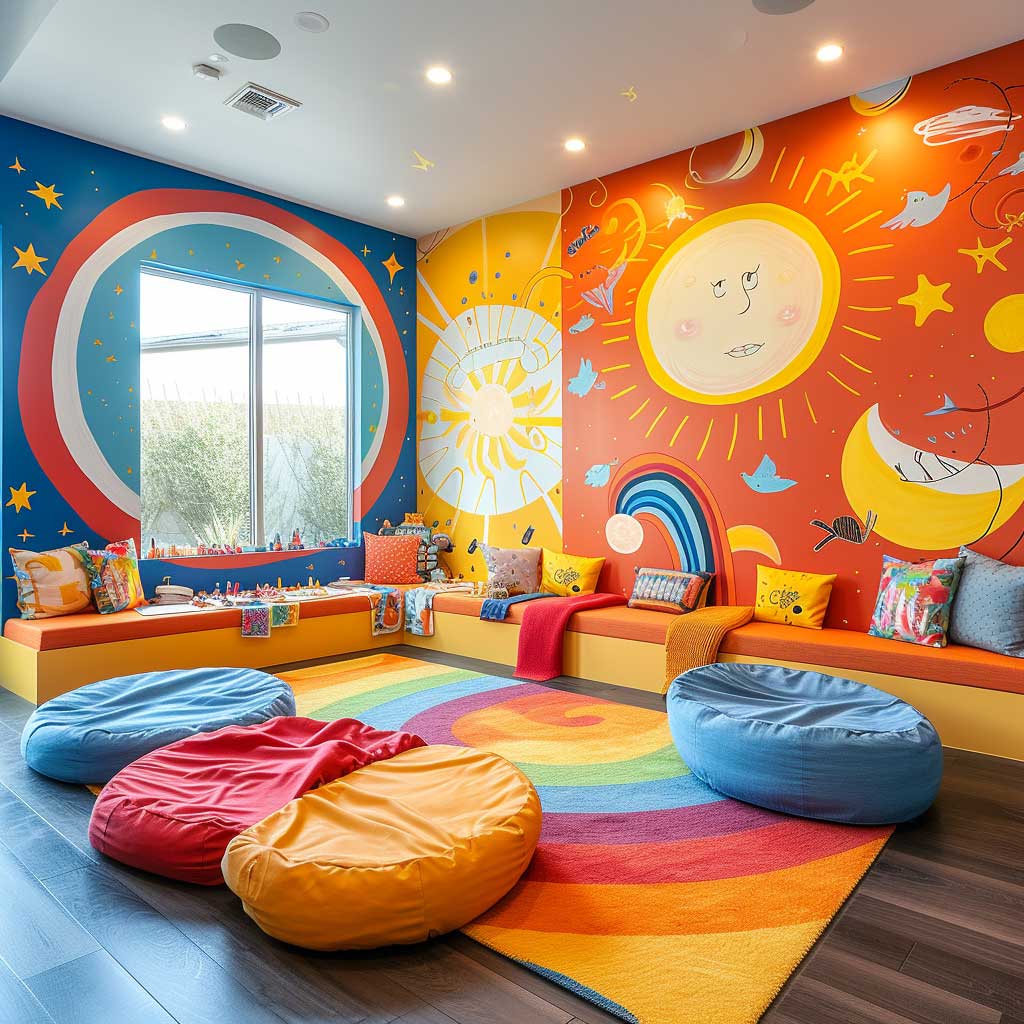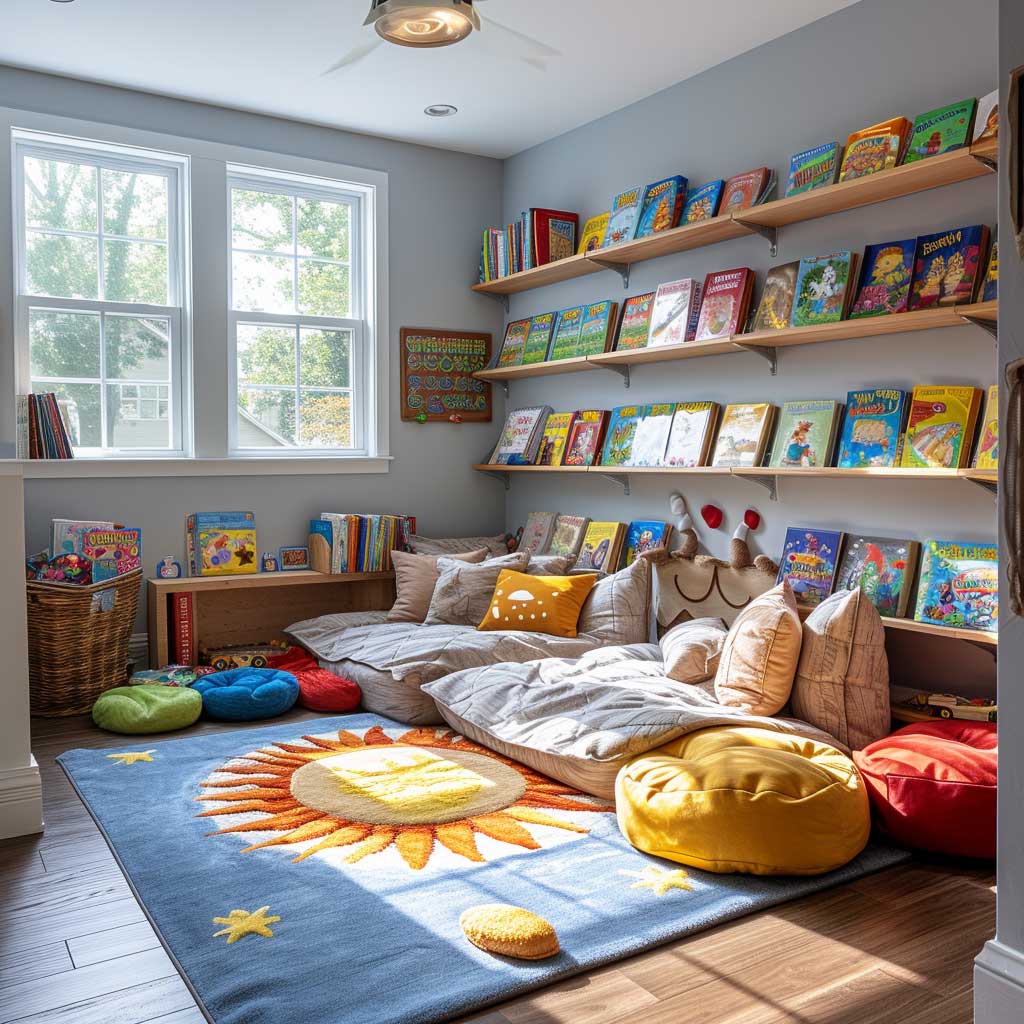Creating a vibrant and stimulating environment for children to play and grow is essential in nurturing their creativity and development. A well-designed kids play room can offer just that—a safe and inviting space that encourages exploration, imagination, and fun. With thoughtful decoration and smart layout choices, parents can craft an area that not only looks great but also supports their children’s needs. This guide provides practical decorating tips to help you design an inspiring playroom that will become the heart of countless adventures and cherished memories for your little ones.
Colorful Oasis for Creative Minds




Creating a colorful oasis for creative minds within the confines of a kids play room is not just about splashing vibrant hues across the walls; it’s about crafting an environment that stimulates creativity, invites curiosity, and nurtures the imaginative capabilities of young minds. This space is envisioned as a sanctuary where children can freely express themselves through art, storytelling, and play, away from the structured routines of daily life.
The foundation of such a playroom lies in its color palette. Colors have a profound impact on a child’s psychological well-being and can significantly influence their mood and creativity. Warm colors like red, orange, and yellow can energize and inspire, while cool tones such as blue and green can have a calming effect. By incorporating a spectrum of colors, the playroom can cater to various activities, from the energetic bursts of dance and play to the quiet moments of reading and drawing.
Furniture and storage in this creative oasis should be as colorful and versatile as the room itself. Multi-functional pieces, like tables with built-in storage for art supplies or benches that double as bookshelves, not only save space but also encourage children to engage with the room’s amenities actively. Seating should be comfortable and accessible, with bean bags, floor cushions, and small chairs, allowing children to find their perfect spot to sketch, build, or dream.
The walls of this kids play room serve as blank canvases for expression and inspiration. One wall might feature a large mural that sparks imaginative play and storytelling, while another could be painted with chalkboard paint, providing an ever-changing platform for doodles and artistic endeavors. Interactive wall decals, such as peel-and-stick scenes from nature or outer space, can also add an element of fun and exploration.
Ortho Home Defense Insect Killer for Indoor & Perimeter2 with Comfort Wand, Controls Ants, Roaches, and Spiders, 1.1 gal
$20.99 (as of 19.05.2025 15:01 GMT +04:00 - More infoProduct prices and availability are accurate as of the date/time indicated and are subject to change. Any price and availability information displayed on [relevant Amazon Site(s), as applicable] at the time of purchase will apply to the purchase of this product.)



Lighting plays a crucial role in setting the atmosphere of the playroom. Natural light should be maximized to foster a bright and welcoming environment, supplemented by a mix of overhead lighting and task lighting to accommodate various activities throughout the day. Creative lighting solutions, like colorful LED strips or whimsical lampshades, can add to the room’s playful ambiance.
To truly embody the essence of a colorful oasis for creative minds, the playroom must be equipped with an array of materials that invite artistic expression. An art station stocked with papers, crayons, markers, paint, and brushes encourages visual art, while a corner filled with costumes and props can inspire dramatic play. Incorporating elements of nature, such as plants or a small indoor sandbox, can also stimulate sensory play and connect children with the natural world.
Safety and comfort should underline every aspect of the playroom design. Flooring should be soft and forgiving, with rugs or foam tiles to cushion falls and provide a comfortable surface for play. Furniture corners should be rounded, and materials non-toxic, ensuring that the environment is as safe as it is stimulating.
In designing a colorful oasis for creative minds, the goal is to create a space that not only looks inviting but also actively contributes to a child’s development. This kids play room is a place where imagination knows no bounds, and creativity is the currency of play. It’s a space where children can explore their interests, develop new skills, and, most importantly, enjoy the freedom to be themselves.
Crafting an Interactive Learning Hub in the Kids Play Room




The concept of an interactive learning hub within a kids play room transcends the traditional boundaries of play by merging it with educational opportunities. This space is designed to cultivate a love for learning, encourage curiosity, and support the intellectual growth of children through interactive play. The essence of this hub is to make learning an adventure, filled with discovery and joy, seamlessly integrating educational elements into the fabric of play.
Barossa Design Plastic Shower Liner Clear - Premium PEVA Shower Curtain Liner with Rustproof Grommets and 3 Magnets, Waterproof Cute Lightweight Standard Size Bathroom Curtains - Clear
$7.95 (as of 19.05.2025 15:01 GMT +04:00 - More infoProduct prices and availability are accurate as of the date/time indicated and are subject to change. Any price and availability information displayed on [relevant Amazon Site(s), as applicable] at the time of purchase will apply to the purchase of this product.)At the heart of the interactive learning hub are stations dedicated to various educational themes and activities. Each station, thoughtfully designed, focuses on a specific learning area such as science, math, literature, or art, inviting children to engage in hands-on, experiential learning. These stations are equipped with interactive tools and resources, such as puzzles that teach problem-solving, maps for geographical exploration, building blocks for understanding physics, and art supplies for creative expression.
Technology, when used appropriately, can enhance the learning experience. Digital interactive boards or tablets loaded with educational apps can provide dynamic learning sessions that adapt to the child’s pace and interests. However, the emphasis remains on moderation and the thoughtful integration of technology, ensuring that it complements rather than dominates the learning experience.
To foster a love for reading and literature, the playroom includes a cozy reading nook. This inviting corner, filled with a range of books suitable for different age groups and interests, serves as a quiet retreat where children can immerse themselves in stories and adventures. Soft seating, adequate lighting, and easy access to books encourage children to explore the world through reading, laying the foundation for lifelong literacy.




The design of the interactive learning hub is mindful of flexibility, allowing the space to evolve with the child’s changing interests and developmental stages. Modular furniture and reconfigurable learning stations ensure that the playroom can adapt to new educational themes, keeping the environment fresh and engaging. This adaptability ensures that the playroom remains relevant and stimulating, providing lasting value beyond the early years.
Incorporating elements of nature and the environment into the interactive learning hub can teach children about sustainability and the natural world. Simple additions like a small indoor garden for learning about plant life cycles or recycling bins for lessons on sustainability can instill important values from a young age. These practical experiences enrich children’s understanding of their role in the larger ecosystem.
JISULIFE Handheld Mini Fan, 3 IN 1 USB Rechargeable Portable Fan [12-19 Working Hours] with Power Bank, Flashlight, Pocket Design for Travel/Summer/Concerts/Lash, Gifts for Women (Pink)
$14.39 (as of 19.05.2025 15:01 GMT +04:00 - More infoProduct prices and availability are accurate as of the date/time indicated and are subject to change. Any price and availability information displayed on [relevant Amazon Site(s), as applicable] at the time of purchase will apply to the purchase of this product.)Safety and accessibility are paramount in the design of the interactive learning hub. Materials and setups must be child-friendly, with non-toxic, durable components and designs that prevent accidents. The layout ensures that all children, regardless of their abilities, can enjoy and learn from the environment, promoting inclusivity and respect for diversity.
Creating an interactive learning hub within a kids play room is an investment in a child’s future, offering a multifaceted environment that blends play with education. This space becomes a cornerstone for developing critical thinking, creativity, and a genuine passion for learning. By surrounding children with opportunities to explore, discover, and question, parents and educators can foster an atmosphere that nurtures well-rounded individuals equipped with the knowledge and skills to navigate the world confidently.
Designing an Adventure Playground Indoors for a Kids Play Room




The notion of bringing the thrill of outdoor adventures into the confines of a home births the concept of an indoor adventure playground within a kids play room. This innovative approach to playroom design is aimed at sparking children’s adventurous spirits and love for exploration, all within the safety and comfort of their own homes. An indoor adventure playground is a dynamic space that challenges children physically and mentally, promoting active play, problem-solving skills, and imaginative storytelling.
Central to the adventure playground is the incorporation of structures that mimic outdoor play equipment, such as climbing walls, slides, and rope bridges. These elements are designed to be safe for indoor use, with appropriate padding and materials that minimize the risk of injury. A climbing wall, for example, not only adds a vertical dimension of play but also encourages physical development and confidence. Meanwhile, a slide can serve as a quick and fun way to move between different areas of the playroom, adding a sense of excitement and fluidity to the space.
The thematic decoration plays a crucial role in transforming the playroom into an adventure playground. By using murals, decals, or even themed play tents, the room can be turned into a jungle, a castle, a pirate ship, or outer space. These themes serve as backdrops for imaginative play, allowing children to fully immerse themselves in their stories and adventures. The visual stimuli provided by these decorations can inspire creative play scenarios, helping children to develop their storytelling and role-playing skills.
Zevo Flying Insect Trap Refill - for The Zevo MAX & Standard Indoor Fly Trap - Catch Gnats, House & Fruit Flies - Easy to Use - Mess-Free Disposal (4 Refill Cartridges)
$14.94 (as of 19.05.2025 15:01 GMT +04:00 - More infoProduct prices and availability are accurate as of the date/time indicated and are subject to change. Any price and availability information displayed on [relevant Amazon Site(s), as applicable] at the time of purchase will apply to the purchase of this product.)To further enhance the adventurous feel, the playroom can include elements that stimulate sensory play and discovery. Hidden nooks, secret tunnels, and treasure chests can be incorporated to encourage exploration and curiosity. These features add an element of surprise and mystery to the playroom, making every play session an opportunity for new discoveries.




Safety is of paramount importance in an indoor adventure playground. Soft flooring materials, such as foam tiles or thick rugs, should be used to cushion falls and reduce the risk of injuries. All structures and play equipment must adhere to safety standards, with smooth edges, secure fastenings, and sturdy construction. Additionally, the room should be spacious enough to allow for free movement, with clear pathways and adequate supervision.
In designing an indoor adventure playground, flexibility and adaptability are key considerations. As children grow and their interests evolve, the playroom should be able to adapt to these changes. Modular play structures and removable decorative elements can allow for easy updates and modifications, ensuring the playroom remains relevant and exciting over time.
An indoor adventure playground within a kids play room is a sanctuary for active, imaginative play. It provides a safe environment for children to challenge themselves, explore new worlds, and embark on endless adventures. This space not only caters to the physical development of children but also nurtures their creativity, problem-solving abilities, and love for exploration. In creating such a playroom, parents and designers craft an engaging, dynamic environment that enriches the childhood experience, fostering a sense of adventure that children will carry with them throughout their lives.
Designing an inspiring playroom for children is about creating a space that feels both magical and functional. By incorporating vibrant colors, interactive elements, and thematic decor, parents can develop an environment that stimulates their children’s imagination and supports their growth. The key is to balance aesthetic choices with practical considerations, ensuring the playroom is not only a place of joy and creativity but also safe and comfortable. With these decorating tips and ideas, transforming any room into a wonderland of possibilities becomes an exciting journey, promising endless fun and learning opportunities for kids.
















